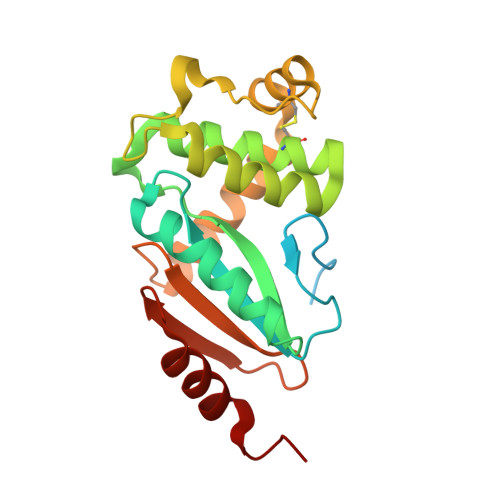Dissecting the machinery that introduces disulfide bonds in Pseudomonas aeruginosa.
Arts, I.S., Ball, G., Leverrier, P., Garvis, S., Nicolaes, V., Vertommen, D., Ize, B., Tamu Dufe, V., Messens, J., Voulhoux, R., Collet, J.F.(2013) mBio 4: e00912-e00913
- PubMed: 24327342
- DOI: https://doi.org/10.1128/mBio.00912-13
- Primary Citation of Related Structures:
4N30 - PubMed Abstract:
Disulfide bond formation is required for the folding of many bacterial virulence factors. However, whereas the Escherichia coli disulfide bond-forming system is well characterized, not much is known on the pathways that oxidatively fold proteins in pathogenic bacteria. Here, we report the detailed unraveling of the pathway that introduces disulfide bonds in the periplasm of the human pathogen Pseudomonas aeruginosa. The genome of P. aeruginosa uniquely encodes two DsbA proteins (P. aeruginosa DsbA1 [PaDsbA1] and PaDsbA2) and two DsbB proteins (PaDsbB1 and PaDsbB2). We found that PaDsbA1, the primary donor of disulfide bonds to secreted proteins, is maintained oxidized in vivo by both PaDsbB1 and PaDsbB2. In vitro reconstitution of the pathway confirms that both PaDsbB1 and PaDsbB2 shuttle electrons from PaDsbA1 to membrane-bound quinones. Accordingly, deletion of both P. aeruginosa dsbB1 (PadsbB1) and PadsbB2 is required to prevent the folding of several P. aeruginosa virulence factors and to lead to a significant decrease in pathogenicity. Using a high-throughput proteomic approach, we also analyzed the impact of PadsbA1 deletion on the global periplasmic proteome of P. aeruginosa, which allowed us to identify more than 20 new potential substrates of this major oxidoreductase. Finally, we report the biochemical and structural characterization of PaDsbA2, a highly oxidizing oxidoreductase, which seems to be expressed under specific conditions. By fully dissecting the machinery that introduces disulfide bonds in P. aeruginosa, our work opens the way to the design of novel antibacterial molecules able to disarm this pathogen by preventing the proper assembly of its arsenal of virulence factors.
Organizational Affiliation:
WELBIO, Brussels, Belgium.














